Note: This is a guest post I contributed over at Capitalism.com.
Business name? Check ✅.
Product idea? Got it ✅.
Decided on an e-commerce platform? Uhhh… 🤷
Choosing the right e-commerce platform for your business can be tricky, especially when there are so many good options available on the market today.
Truthfully, there is no ‘best‘ platform.
It really depends on what you’ll need out of it.
Do you want something easy to use? Do you need it to integrate with certain apps? Will you be developing custom functionality? Are you on a budget?
But if you’re like most entrepreneurs, you probably already have a million things on your to-do list. The last thing you want to do is spend hours going through each platform’s feature list & documentation.
Don’t worry, you’re in luck!
In this blog post, we’ll be comparing two of the most popular options – Shopify and WooCommerce – to help you decide which platform is best suited for your physical product business.
Initial Setup
Before we get into the setup process for each platform, it’s important that you understand one key distinction.
Shopify is a standalone platform, whereas WooCommerce is a self-hosted solution.
What does that mean?
Well, with Shopify, you don’t need to worry about hosting your own website. You don’t need to worry about things like server specs or uptime.
All of that is taken care of by Shopify as part of their monthly fee.
WooCommerce on the other hand is a free plugin that you install on your own WordPress site.
That means you’ll need to find a hosting provider and set up a WordPress website before you can start using WooCommerce.
This doesn’t take more than an hour or two, but it is an extra step to make note of.
P.S. we wouldn’t recommend any of those $5/mth hosting offers you see.
WooCommerce is rather resource-intensive, so you’ll want to go with a reputable hosting provider like Kinsta or WP Engine.
Verdict
If you’re looking for an e-commerce platform where you can get your store up and running in minutes, Shopify is a better fit.
With Shopify all you need to do is sign up for an account, pick a theme, and publish your first product.
If you’re looking for an e-commerce platform where you maintain all control – of your server, your files, and your data, WooCommerce is the better option.
The setup process is a bit more involved, but the benefit is that you won’t be reliant on a third-party platform and you’ll have 100% control over everything.
Design and Customization
Shopify
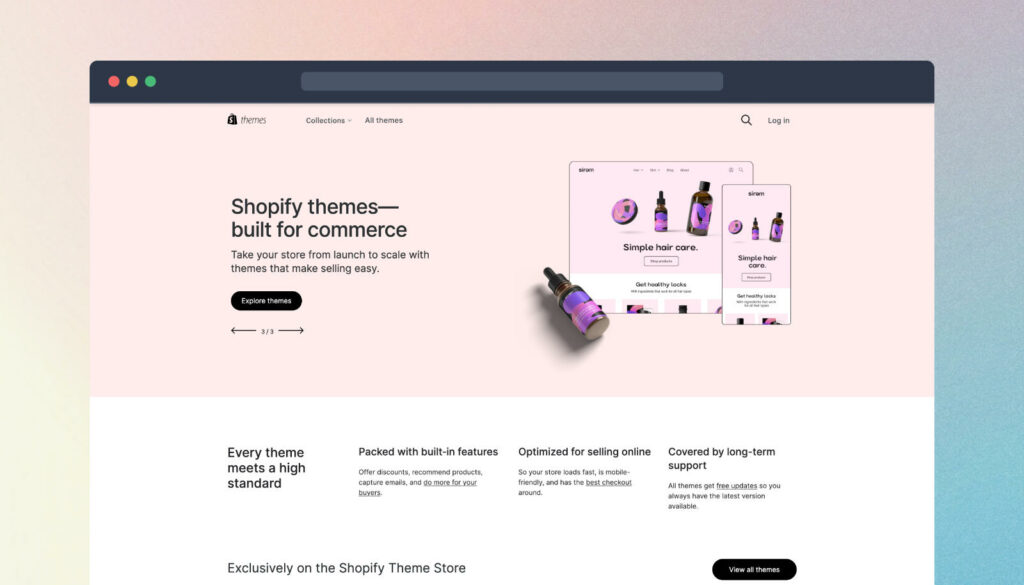
You control the look of your site using Shopify themes.
Their theme store has a good selection of both free and premium themes.
The free themes are great for getting started, but are generally what-you-see-is-what-you-get and only come with basic customization options.
Premium themes can cost upwards of $400 USD, but usually have way more layouts, sections, and elements included.
If you instead want to create a completely custom design from scratch, things start getting pretty expensive.
Custom themes can easily run you tens of thousands of dollars as they need to be custom coded.
Shopify does have a few visual page builders available, but in our experience they can be a little clunky.
WooCommerce

WooCommerce can be styled using your WordPress theme.
Like Shopify, there are many free and premium themes that are designed specifically for WooCommerce stores.
One advantage WooCommerce has over Shopify here is that it’s much easier to create a custom design.
Popular page builders for WordPress now come with advanced WooCommerce integrations, and let you visually style every element of your WooCommerce site.
(If you decide to go with WooCommerce, here’s a helpful guide to choosing the right page builder).
Verdict
Shopify themes often look nicer than WooCommerce themes out-of-the-box.
If you can find a design you like, it’ll probably be easier to create a beautiful store on Shopify.
However, if you’re looking to build a completely custom design or want more control over every aspect of your store, WooCommerce is the better platform.
General Ease of Use
Shopify
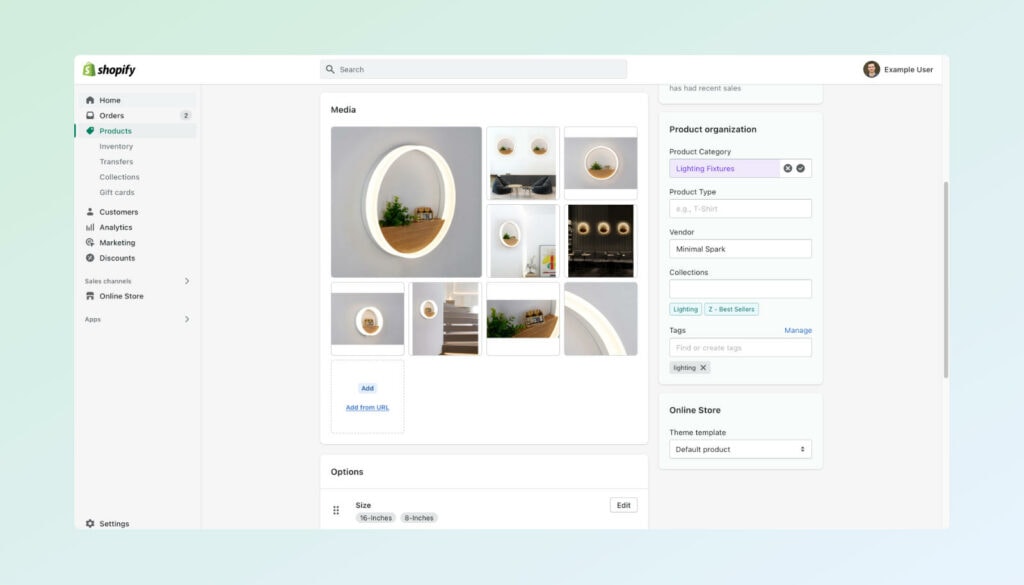
Adding products, managing orders, and processing payments are all straightforward and can be done without any technical knowledge.
There are also a ton of apps available on the Shopify app store that can add extra functionality to your store (more on that later).
All of this is managed using a simple, intuitive interface that is easy to navigate.
In terms of editing content or adding pages, most modern themes come with sections that you can re-order on the page or click to edit the text.
WooCommerce
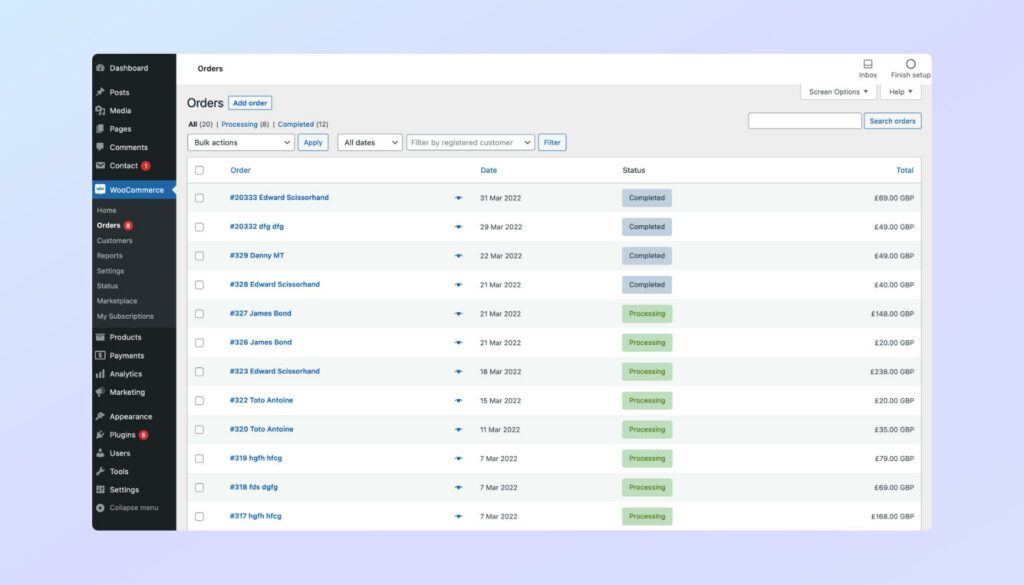
Day-to-day tasks like creating products, managing orders, and processing payments are all possible without any technical knowledge as well.
Rather than apps, WooCommerce uses extensions & plugins to add new features.
Creating or editing pages is where things may get more complicated though.
This will depend on what theme or page builder was used to build your store, but you’ll likely benefit from having a web designer on hand to make larger changes.
Verdict
Non-techies can manage just about every aspect of their store, making Shopify very easy to use.
Day-to-day tasks are easy to manage in WooCommerce, but it may be more difficult to make customizations or edit your pages.
Integrations
Shopify
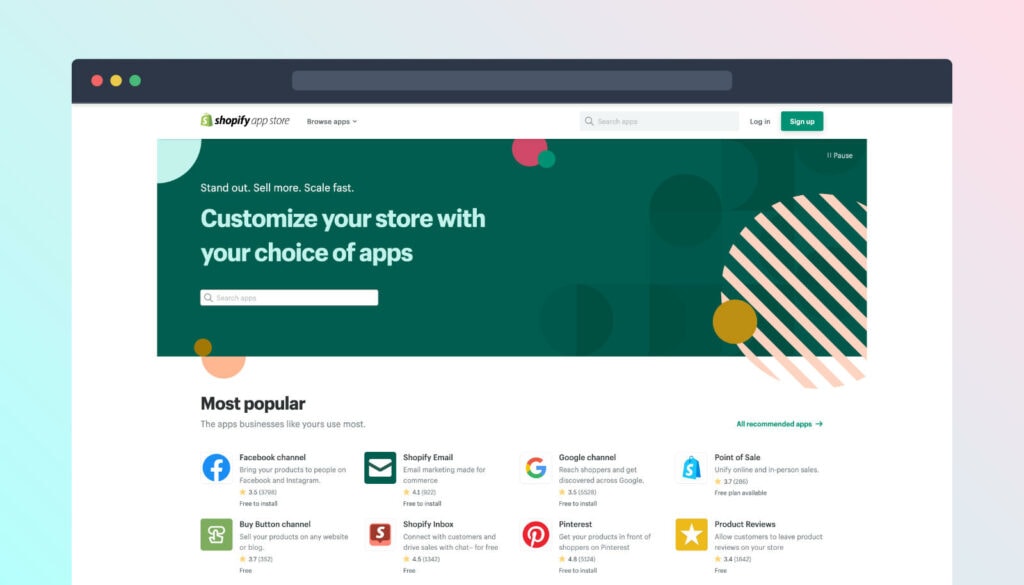
Shopify comes with a growing app store that includes both free and paid apps.
These apps are designed to add new functionality or integrate with popular third-party software (like accounting, marketing, etc.) to make running your store easier.
Many these apps are well-developed as they need to meet certain requirements to be published on the Shopify app store.
While the apps cover a wide range of use-cases, one common complaint is that most come with a monthly subscription.
You’ll definitely want to budget for more than just the base Shopify subscription as the cost of apps can begin to add up quickly.
WooCommerce

Since WooCommerce is an open-source platform powered by WordPress, there are thousands of plugins available.
You can often find a plugin for anything you think of.
WooCommerce plugins are also more known to have a generous free version or an affordable paid plan.
You’re more likely to find plugins that are one-time payments versus a monthly subscription, which can help keep costs down as your store begins to expand.
That being said, they don’t need to be submitted to the official marketplace so the quality may vary.
You’ll want to make sure you’re only downloading plugins from reputable developers who focus on publishing high-quality code and maintaining their products.
Verdict
Shopify has a wide range of high-quality apps available, but often come with a costly subscription.
WooCommerce has even more plugins available and they tend to be more affordable, but you may need to do more research before installing them.
Blogging
Shopify
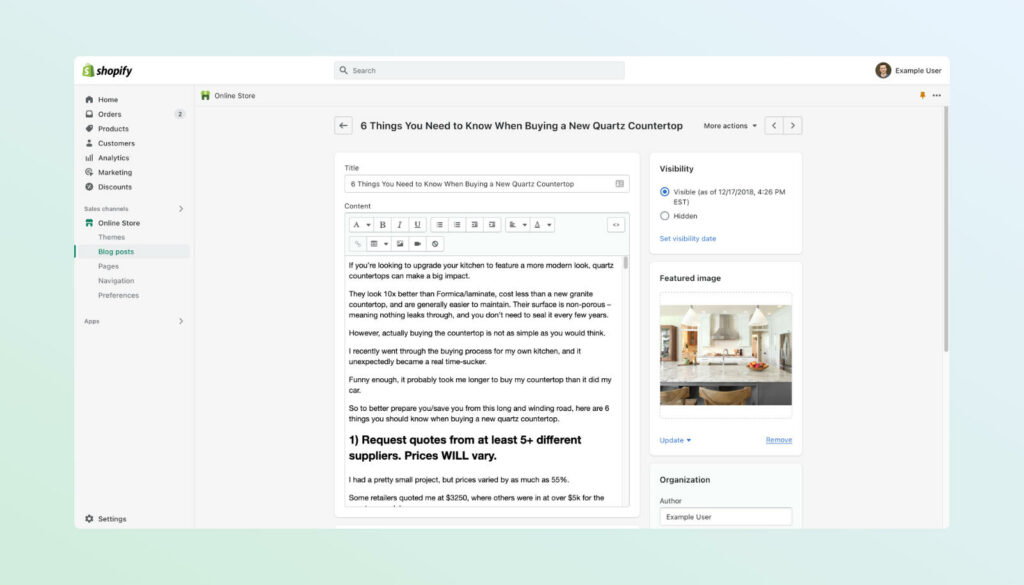
Shopify’s simplicity serves it well in many areas, but not so much when it comes to creating a blog on your site.
The post editor is quite basic, and you’ll mostly want to stick with simple text & image post formats.
Another downside of Shopify’s blogging feature is the lack of control over URL structure.
Normally, you’ll see many blogs on the internet with a simple URL structure like “domain.com/example-review/”, which not only looks cleaner but is also better for SEO.
With Shopify, you’re forced to use a URL structure like “domain.com/blogs/reviews/example-review/”.
WooCommerce
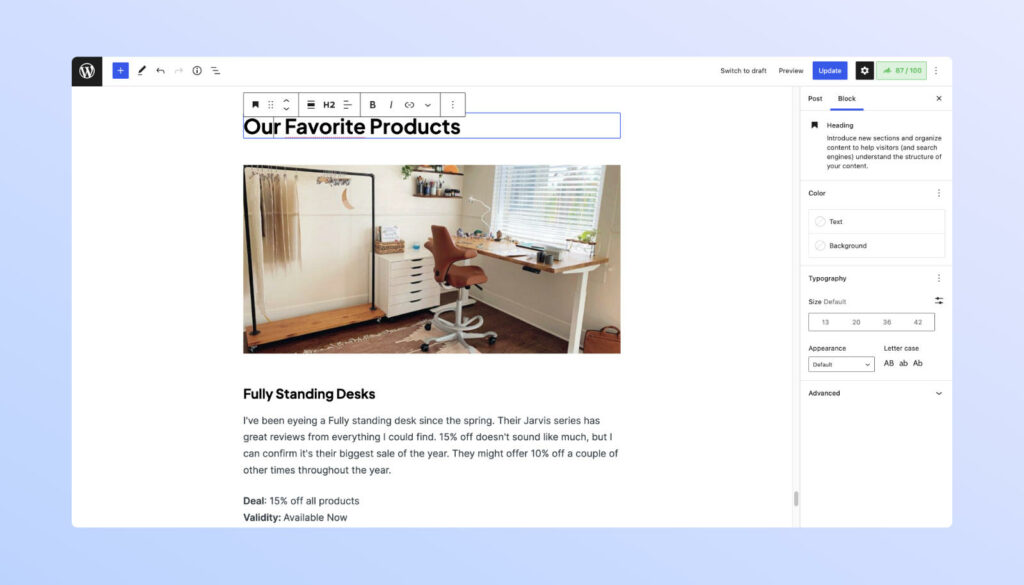
WooCommerce is based on WordPress, which made its name as a blogging platform.
Because you’re able to use WordPress as your foundation, you’ll enjoy a much better blogging experience.
The post editor (Gutenberg) is far more advanced and has a library of blocks you can use within your content.
You also have full control over the URL structure of your blog posts – which as we just discussed, is better for SEO.
Verdict
If blogging is a core part of your content marketing strategy, WooCommerce/WordPress will serve you better.
If Shopify checks every other box for you, you can still use Shopify for your store but install WordPress on a subdomain for your blog.
If you decide to use Shopify and blogging isn’t a core part of your content marketing strategy, then their native blog will work just fine for you and you don’t need to worry about setting up a separate blog.
Cost
Shopify
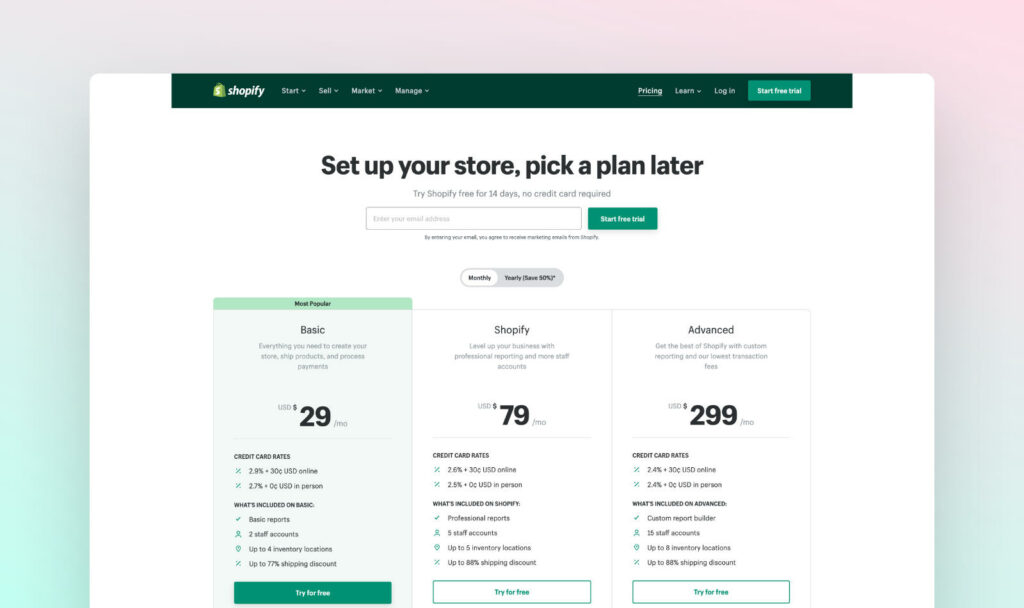
Shopify offers three main plans, starting at $29/month for the Basic plan and up to $299/month for the Advanced plan.
The core features are quite similar throughout all plans, making the Basic plan a good place to start.
As you move up, you enable lower credit card processing fees, more advanced reporting, more staff accounts, more inventory locations and a better shipping discount.
There is also a separate plan called Shopify Plus, which enables more enterprise-level features and starts at $2k/month.
You’ll also need to budget for any themes or apps you want to add on top of the subscription cost.
Themes can vary from free to $400 (one-time payment).
Apps are even more wide-ranging, as they can vary from free to hundreds of dollars per month based on your usage.
WooCommerce
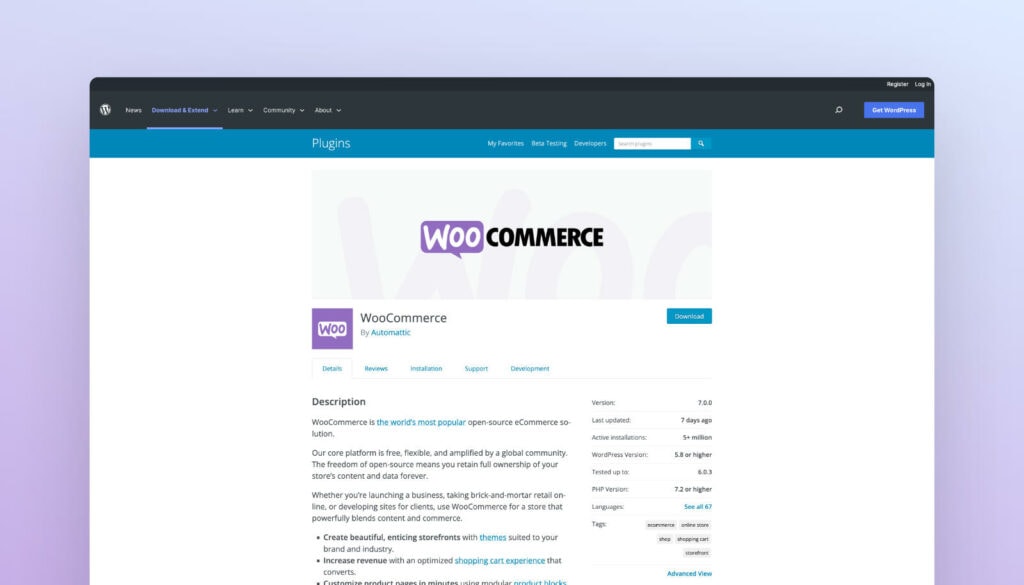
Since WooCommerce is open-source, it can be freely downloaded from the WordPress plugin repository. There is no monthly subscription.
However, you will need a host for your website which can start at $30/month. Your server costs will increase as your traffic scales.
Aside from hosting, your other cost categories will be similar to Shopify.
You’ll need a theme or custom design built.
You’ll need to integrate with a payment processor like Stripe or PayPal, who take 2.9% + $0.30 per transaction depending on your sales volume.
And if you’re using any third-party plugins, you may have a one-time payment or yearly subscription.
Verdict
Determining whether Shopify or WooCommerce will be cheaper is almost entirely dependant on the apps/plugins you decide to use.
Shopify has a monthly subscription, but it will come close to your WordPress hosting costs.
When you start stacking apps/plugins, that’s when Shopify typically tends to get more expensive.
WooCommerce is often the more affordable option, simply because the plugins don’t cost as much.
Important Note: Aside from the direct costs of the platform, it’s also important to consider time savings or the ROI that a potential app/feature might bring.
If one platform has an app that costs $39/mth but will save you 5 hours/mth or help your store generate thousands of dollars, you should certainly factor that into your equation.
Recommendation
At this point, you might already have a good idea which platform is better suited for you.
Both platforms offer great options for physical product brands, and you can’t really go wrong with either.
You may have noticed a common theme:
- Shopify is designed for businesses who want to sell online with as little hassle as possible.
- WooCommerce is designed for businesses who want full control over their e-commerce experience.
If you’re looking for an easy-to-use platform that offers a wide range of high-quality features and integrations, then Shopify is a good option.
If you’re looking for more control over every aspect your store and don’t mind taking ownership of the technical aspects, then WooCommerce offers a lot of flexibility.
Before making a final decision, we’d recommend spending a few minutes looking up the specific apps & integrations you think you might need.
This will help make your decision even more clear.
Other Alternatives
While Shopify and WooCommerce are two of the most popular platforms, they’re not the only options for physical product brands.
If you don’t run a traditional store with tens/hundreds of products in your catalogue, you might find one of these alternatives to be a better fit.
They focus more on building funnels and allow you to easily create custom landing pages, checkouts, order bumps, upsells, and thank you pages.
SureCart
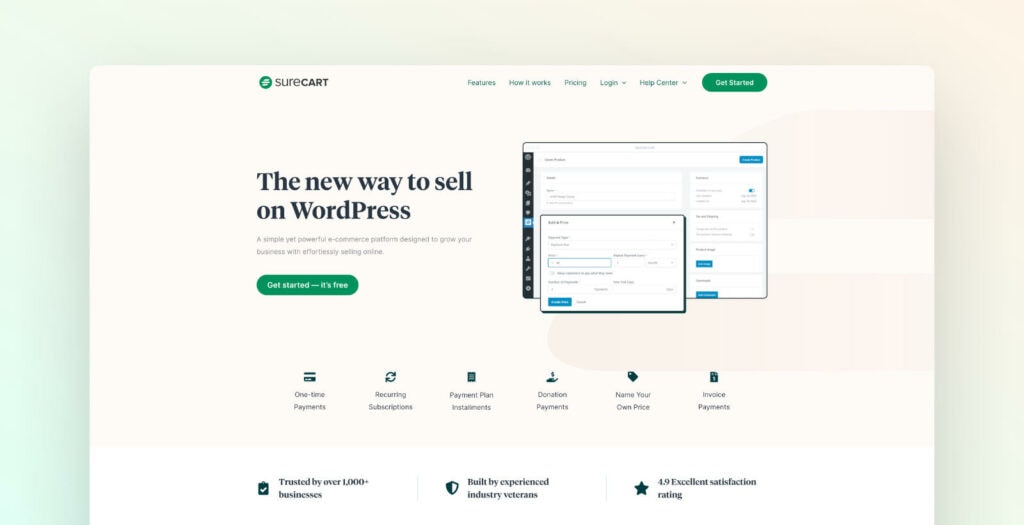
SureCart is a new e-commerce solution for WordPress that lets you build custom checkouts and add them to any page.
This means that you can use whatever theme or page builder you’d like to build your pages, giving you complete design freedom.
While it is a native WordPress plugin, all the heavy-lifting takes place on SureCart’s servers.
That makes it less resource-intensive than something like WooCommerce, and you won’t need to worry about slowing your site down or paying for an expensive server.
You can read an in-depth review of SureCart here.
ClickFunnels

ClickFunnels is another popular all-in-one SaaS solution worth considering.
You won’t have the same level of design freedom as you do with SureCart, but ClickFunnels has an easy-to-use visual builder that makes it easy to create professional e-commerce pages without any coding or design experience.
It has an engaged community with a ton of tutorials and templates available.
It also includes features like abandoned cart recovery, upsells and order bumps, and integrations with popular payment processors.
Final Thoughts
At the end of the day, both WooCommerce and Shopify are great e-commerce platforms for selling physical products online.
We really like Shopify for traditional e-commerce stores, and WooCommerce for more custom use-cases.
Ultimately, it’s important to choose the platform that’s best suited for your business’ specific needs.
That’s all for this one.
Thanks for reading!



